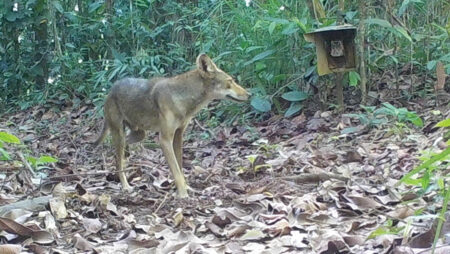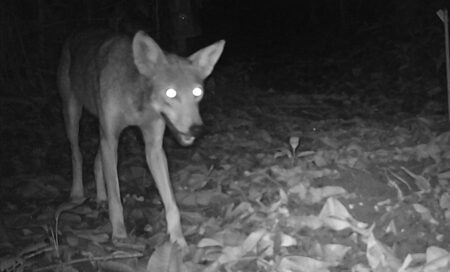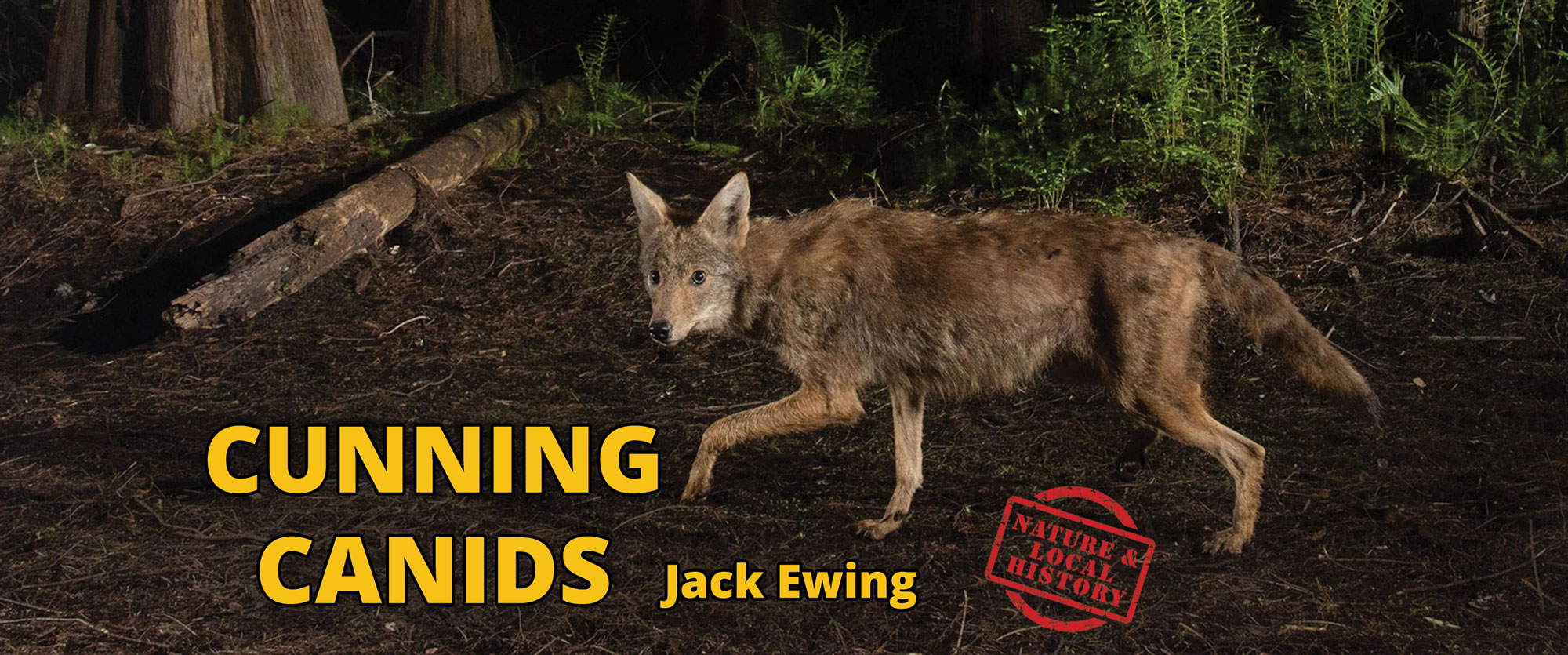Cunning Canids
Remember Wile E. Coyote who wasn’t quite as wily as Beep-Beep the roadrunner? Unlike Wile, real coyotes are indeed cunning. According to Mark Wainright’s excellent field guide The Mammals of Costa Rica, coyotes have even been known to play dead as a ruse to lure in scavengers whom they then kill and eat. I guess Wile didn’t know that trick or it didn’t work on the roadrunner. In Mexico the term muy coyote is used when referring to a shrewd or crafty person.
 When I was a kid growing up in Colorado in the 1950s, I used to shoot every coyote I saw. I remember how pitiful it was seeing a flock of my dad’s sheep that had been maimed and killed by them. We would have all been very happy had they been completely exterminated. In fact, there was a government program to do exactly that. The agricultural department gave us traps, each of which, had a corn cob screwed onto to a short tube. When the coyote pulled on the corn cob the trap shot a pellet of cyanide into its mouth killing it instantly. When we set the traps, we painted the cobs with pheromone laced oil. Coyotes couldn’t resist the aroma, grabbed the corn cob with their teeth, and ended up dead. Either the government has given up the program to exterminate the coyotes, or the coyotes are wilier than the government. There are still as many coyotes as ever, and they have adapted to many different habitats, even including cities.
When I was a kid growing up in Colorado in the 1950s, I used to shoot every coyote I saw. I remember how pitiful it was seeing a flock of my dad’s sheep that had been maimed and killed by them. We would have all been very happy had they been completely exterminated. In fact, there was a government program to do exactly that. The agricultural department gave us traps, each of which, had a corn cob screwed onto to a short tube. When the coyote pulled on the corn cob the trap shot a pellet of cyanide into its mouth killing it instantly. When we set the traps, we painted the cobs with pheromone laced oil. Coyotes couldn’t resist the aroma, grabbed the corn cob with their teeth, and ended up dead. Either the government has given up the program to exterminate the coyotes, or the coyotes are wilier than the government. There are still as many coyotes as ever, and they have adapted to many different habitats, even including cities.
I have not been a rancher for many years, and I don’t hate coyotes anymore. I admire them. When we still had cattle on Hacienda Barú I worried that they would kill the newborn calves but getting past a furious 300 to 500-kilo mother cow is a huge risk for a 10-kilo canid. Coyotes did hang out around the cattle at calving time, but I believe they did so to feed on the afterbirth (fetal membranes and placenta) that the cows expelled after giving birth.
 When the lowlands of Hacienda Barú were mostly pasture there were lots of coyotes. Coyotes are less inclined to hunt in packs than wolves, and when they do the packs are small and made up of close family members. The species is somewhat monogamous, and a pack is made up an alpha male and female, that may stay together for several years, along with their cubs from the last few years. We all loved hearing them howl in the early mornings and late evenings. In fact, the name coyote is derived from the word coyotl from language náhuatl, spoken by the Aztecs, and meaning “howling dogs”. As the hacienda was rewilded and transformed into a nature reserve, the pastures evolved into secondary forests and the howling diminished and eventually stopped completely. I think that coyotes in a forested habitat tend to be solitary rather than forming packs, and solitary coyotes don’t seem to howl. I didn’t start using trail cameras until about 15 years after Hacienda Barú was declared a National Wildlife Refuge, by which time it was mostly forested, and I have never captured of photo of more than one coyote. Their social behavior has evolved along with the environment.
When the lowlands of Hacienda Barú were mostly pasture there were lots of coyotes. Coyotes are less inclined to hunt in packs than wolves, and when they do the packs are small and made up of close family members. The species is somewhat monogamous, and a pack is made up an alpha male and female, that may stay together for several years, along with their cubs from the last few years. We all loved hearing them howl in the early mornings and late evenings. In fact, the name coyote is derived from the word coyotl from language náhuatl, spoken by the Aztecs, and meaning “howling dogs”. As the hacienda was rewilded and transformed into a nature reserve, the pastures evolved into secondary forests and the howling diminished and eventually stopped completely. I think that coyotes in a forested habitat tend to be solitary rather than forming packs, and solitary coyotes don’t seem to howl. I didn’t start using trail cameras until about 15 years after Hacienda Barú was declared a National Wildlife Refuge, by which time it was mostly forested, and I have never captured of photo of more than one coyote. Their social behavior has evolved along with the environment.
Coyotes have not been studied as much as other predators in Costa Rica, but studies from north America abound. An adult coyote will weigh around 10 kilos in Costa Rica and will average almost double that in Alaska. This is presumably because their prey here is smaller than that of their northern relatives. Scat analysis has shown that in Costa Rica they do eat white-tailed deer weighing three times as much as themselves, but researchers believe that the coyotes don’t kill the deer, rather they scavenge carcasses of deer that have died from other causes. Their diet in Costa Rica is quite diverse, consisting of mice, rats, rabbits, agoutis, green iguanas, spiny-tailed iguanas, several species of birds, turtle eggs, large insects and just about anything else they can catch and kill. When animal protein is not available coyotes eat fruits, large seeds, and grass. Killing and eating chickens and other poultry earns them a bad reputation with farmers, as does eating and damaging crops like squash and cantaloupe.
In addition to our wily and cunning coyotes (Canis latrans), two other canids are found in Costa Rica, the gray fox (Urocyon cinereoargenteus), and the bush dog (Spethos venaticus). We all know that foxes are sly and foxy. The sarcastic expression “dumb like a fox” means just the opposite of what the words say. But what about the bush dogs? They were discovered in Costa Rica less than 10 years ago, and we don’t know much about them. I suspect that they had been here for a long time before a biologist captured images of one on a trail camera. So, they must be both cunning and sly to stay so well hidden from the searching eyes of researchers, naturalists, and those of us who dwell in rural Costa Rica.
Jack Ewing was born and educated in Colorado. In 1970 he and his wife Diane moved to the jungles of Costa Rica where they raised two children, Natalie and Chris. A newfound fascination with the rainforest was responsible for his transformation from cattle rancher into environmentalist and naturalist. His many years of living in the rainforest have rendered a multitude of personal experiences, many of which are recounted in his published collection of essays, Monkeys are Made of Chocolate. His latest book is, Where Jaguars & Tapirs Once Roamed: Ever-evolving Costa Rica.

